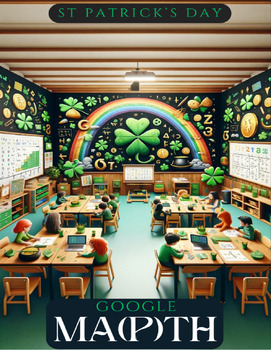Google Ma(p)th: St. Patrick's Day Treasure Hunt
- Word Document File
- Google Apps™

Description
Dive into the spirit of St. Patrick's Day with "Google Ma(p)th: St. Patrick's Day Treasure Hunt," an engaging and educational journey designed to enchant 4th and 5th graders. This interactive product combines the thrill of discovery with the challenge of math, guiding students to uncover hidden treasure spots located at significant St. Patrick's Day celebrations across North America and Ireland. By solving math problems, participants will decode the precise coordinates of festivities, from the vibrant streets of New York City to the iconic green-dyed Chicago River, Dublin Ireland, Shamrock, Texas and beyond.
Product Highlights:
- St. Patrick's Day Themed: Explore five unique locations in North America and Ireland, each celebrating St. Patrick's Day with its unique traditions.
- Mathematical Adventure: Utilize math skills to discover the latitude and longitude of each treasure, engaging with addition, subtraction, multiplication, division, and more.
- Hands-On Learning: Incorporate Google Maps for a real-world application of geography, enhancing digital navigation skills.
- Cultural Exploration: Dive into the history and customs of St. Patrick's Day across various North American cities, enriching cultural knowledge.
- Comprehensive Guide Included: Offers detailed instructions for using Google Maps, including how to enter coordinates and explore locations at ground level using Street View.
In the "Box":
- Detailed math problem sets for each location
- Step-by-step solution guide
- Instructions for using Google Maps and Pegman
- Background information on each St. Patrick's Day celebration
Learning Objectives:
- Apply math skills to solve real-world problems
- Understand and use geographical coordinates
- Explore the cultural and historical significance of St. Patrick's Day
- Develop digital literacy through the use of Google Maps
Conclusion:
"Google Ma(p)th: St. Patrick's Day North America Treasure Hunt" is more than just a game; it's a comprehensive educational tool that brings together math, geography, and cultural studies. Perfect for classroom activities or home learning, it offers a fun and immersive way to explore the world, celebrate St. Patrick's Day, and develop essential academic skills. Join us on this magical journey to discover the treasures of North America!





